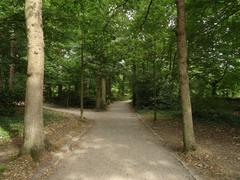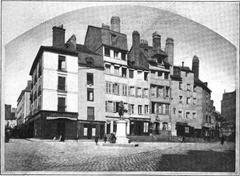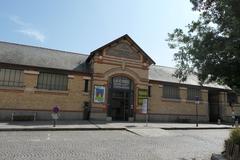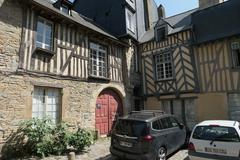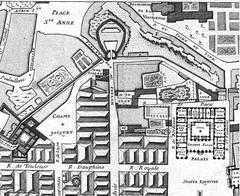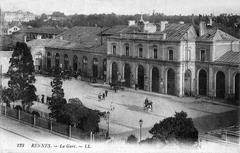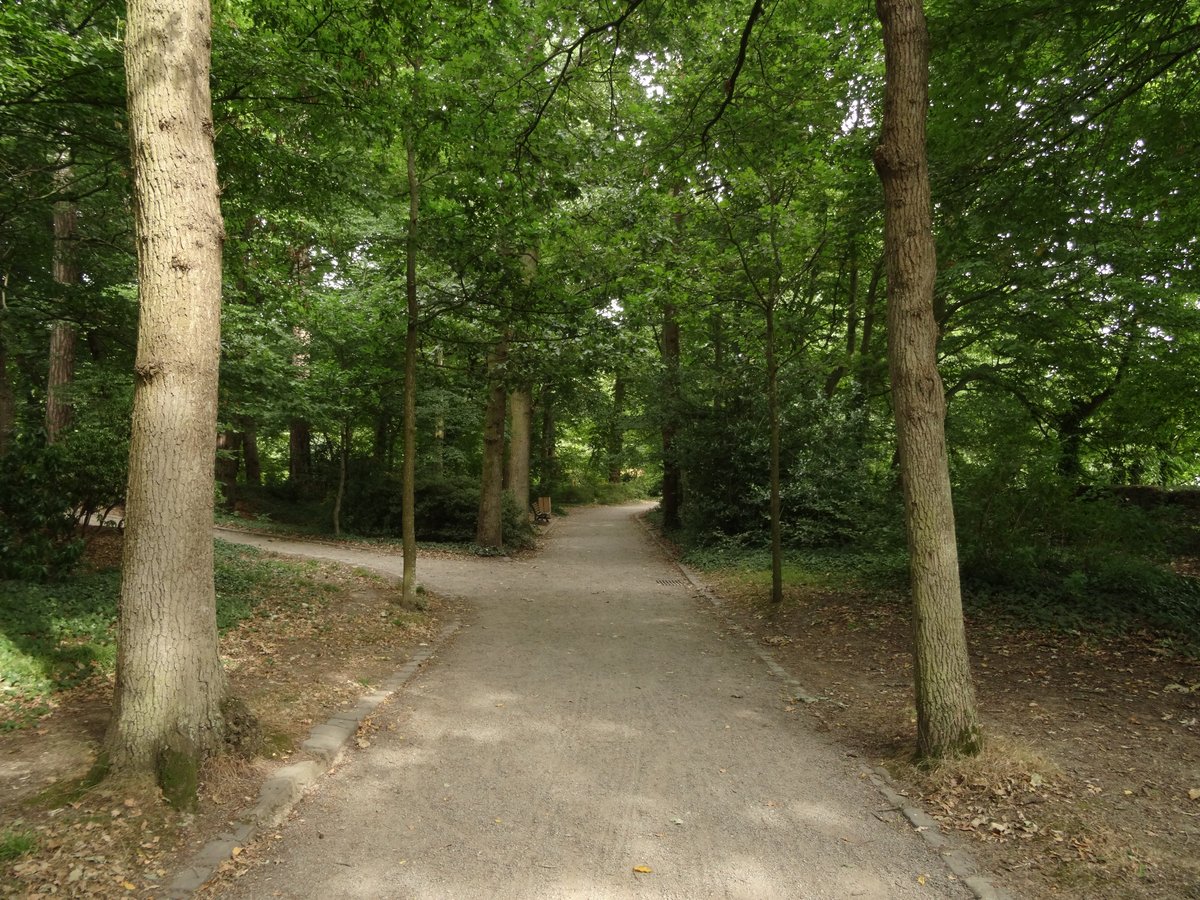
Visiting Hours, Tickets, and Historical Sites of Parc des Hautes-Ourmes in Rennes
Date: 25/07/2024
Introduction
Nestled in the southeastern part of Rennes, France, the Parc des Hautes-Ourmes is a beloved urban green space that offers a tranquil escape from bustling city life. This comprehensive guide aims to provide you with all the essential information you need to make the most of your visit, from historical insights and cultural significance to practical tips and visitor information. Established in the early 1970s as part of an urban development initiative, this park has grown to become a cherished local landmark. Its origins trace back to a small woodland area that was preserved and integrated into the park’s design, reflecting early environmental consciousness (ville.rennes.online.fr). Over the decades, the park has evolved to meet the changing needs of the community, adding various amenities and features that make it a versatile space for relaxation and recreation (wanderlog.com). Whether you’re interested in its historical roots, cultural importance, or simply looking for a peaceful place to unwind, the Parc des Hautes-Ourmes offers something for everyone.
Table of Contents
- Introduction
- History of Parc des Hautes-Ourmes
- Historical Significance
- Cultural Significance
- Environmental Significance
- Recreational Significance
- Accessibility and Connectivity
- Educational Significance
- Community Significance
- Conservation Efforts
- Visitor Information
- Practical Tips
- FAQ
- Conclusion
History of Parc des Hautes-Ourmes
Origins and Development
The Parc des Hautes-Ourmes, established in the early 1970s, marked a significant phase of urban development in Rennes, particularly in the Blosne district. The park was created as part of a broader urban planning initiative aimed at providing green spaces within the rapidly urbanizing area. The location chosen for the park was originally a small woodland area, which was preserved and integrated into the park’s design. This decision reflects early environmental consciousness and the desire to maintain natural elements within urban settings (ville.rennes.online.fr).
Design and Purpose
From its inception, the Parc des Hautes-Ourmes was designed with the community in mind. The planners envisioned a space that would serve as a retreat for residents, offering a place for relaxation and recreation amidst the urban landscape. The park’s layout includes a variety of features catering to different age groups and interests. For instance, the western part of the park features an oak-lined alley leading to a clearing, ideal for family picnics. This thoughtful design underscores the park’s role as a communal space where people can gather and enjoy nature (ville.rennes.online.fr).
Evolution Over the Decades
Since its establishment, the Parc des Hautes-Ourmes has evolved to meet the changing needs of the community. Initially, the park’s primary attractions included basic playground equipment such as swings, slides, and a sandbox. Over the years, additional amenities have been introduced to enhance the visitor experience. For example, a paddling pool was added, which has become a popular feature during the summer months. This shallow pool, surrounded by a grassy area, provides a safe and enjoyable environment for young children while allowing parents to relax nearby (ville.rennes.online.fr).
Cultural and Social Significance
The Parc des Hautes-Ourmes holds significant cultural and social value for the residents of Rennes. It serves as a green oasis in a densely populated urban area, offering a respite from the hustle and bustle of city life. The park’s design and amenities reflect the community’s needs and preferences, making it a beloved local landmark. Over the years, it has hosted numerous community events and activities, further cementing its role as a central gathering place. The park’s continued popularity underscores its importance as a social and recreational hub in the Blosne district (wanderlog.com).
Environmental Impact and Sustainability
The creation of the Parc des Hautes-Ourmes also highlights early efforts in urban environmental sustainability. By preserving the original woodland and integrating it into the park’s design, the planners demonstrated a commitment to maintaining natural habitats within the city. This approach not only provided a green space for recreation but also contributed to the local ecosystem by supporting biodiversity. The park’s ongoing maintenance and development continue to prioritize environmental sustainability, ensuring that it remains a green haven for future generations (ville.rennes.online.fr).
Community Engagement and Future Prospects
Community engagement has been a cornerstone of the park’s history. Local residents have played an active role in shaping the park’s development, providing feedback and suggestions for improvements. This collaborative approach has helped ensure that the park meets the evolving needs of the community. Looking ahead, there are plans to further enhance the park’s facilities and expand its green spaces. These initiatives aim to preserve the park’s legacy while adapting to the changing urban landscape of Rennes (wanderlog.com).
Historical Significance
World War II Era
The Parc des Hautes-Ourmes is steeped in historical significance. Originally, the land was a private property known as Hautes-Ourmes. During World War II, in May 1944, the German forces requisitioned this property to establish a regional cemetery for their soldiers. This cemetery was intended to accommodate 380 graves, with plans to transfer additional remains from the Cimetière de l’Est in Rennes. By the end of the war, the combined number of graves at Hautes-Ourmes and Cimetière de l’Est exceeded 1,000 (wiki-rennes.fr).
Post-War Development
Maintaining the cemetery proved challenging, and by 1961, many of the bodies were either repatriated to Germany at the request of their families or transferred to the German military cemetery at Mont-d’Huisnes, near Mont Saint-Michel (wiki-rennes.fr). Subsequently, the city of Rennes purchased the land to construct a school and develop a public park, which was completed between 1971 and 1976.
Cultural Significance
Community Perception
The park is colloquially known as the “Bois des Allemands” or “Woods of the Germans” by the local residents, a name that has persisted since the German occupation during World War II (wikiwand.com). This nickname serves as a poignant reminder of the area’s historical context and the impact of the war on the local community.
Role in Urban Life
The park is a vital recreational area for the residents of Rennes. It features a large central clearing, which is ideal for picnics, sports, and other outdoor activities. The allée of oak trees that extends along the Léon Grimault school group to the western entrance on Avenue de Pologne adds to the park’s aesthetic appeal and provides shaded walkways for visitors (wikiwand.com).
Environmental Significance
Biodiversity
Spanning 4.5 hectares, the Parc des Hautes-Ourmes is a significant green space within the urban landscape of Rennes. The park boasts 1,250 trees spread over 10,100 square meters, creating a lush environment that supports local biodiversity (wiki-rennes.fr). The large central clearing and the surrounding wooded areas provide a habitat for various species of birds, insects, and small mammals, contributing to the ecological health of the region.
Green Spaces
The park’s ongoing maintenance and conservation efforts ensure that it remains a green haven for future generations. These efforts are supported by the local government and community organizations, highlighting the park’s importance to the city of Rennes (wiki-rennes.fr).
Recreational Significance
Sports Facilities
Parc des Hautes-Ourmes is equipped with various sports facilities, making it a popular spot for fitness enthusiasts. There are jogging and walking trails that wind through the park, offering a serene environment for exercise. Additionally, the park features basketball courts, soccer fields, and tennis courts, catering to a wide range of sports activities.
Picnic Areas
The park has designated picnic areas with tables and benches, perfect for a family outing or a romantic lunch. Visitors are encouraged to bring their own food and beverages, as there are limited food vendors within the park.
Wildlife and Nature
Parc des Hautes-Ourmes is home to a variety of wildlife, including birds, squirrels, and other small animals. Birdwatchers will find the park particularly appealing, with several species of birds nesting in the trees. The park’s ponds and streams also attract ducks and other waterfowl, providing ample opportunities for nature observation and photography.
Accessibility and Connectivity
Public Transportation
Parc des Hautes-Ourmes is well-connected and easily accessible via public transportation. The park is served by the La Poterie metro station and several bus lines, including C2, 11, 12, and 13, with stops near the park (wikipedia.org).
Parking Facilities
For those driving, there are parking facilities available, though it is advisable to arrive early during weekends and holidays to secure a spot.
Educational Significance
Proximity to Schools
The park’s proximity to the Léon Grimault school group underscores its educational significance. The green space provides an outdoor classroom for environmental education, where students can learn about local flora and fauna, the importance of green spaces in urban areas, and the historical context of their community (wiki-rennes.fr).
Outdoor Classroom
The park’s natural setting offers a unique opportunity for hands-on learning experiences, making it an invaluable resource for local schools and educational programs.
Community Significance
Events and Activities
Parc des Hautes-Ourmes serves as a communal gathering space for various events and activities. It hosts local festivals, community gatherings, and cultural events, fostering a sense of community and belonging among the residents of Rennes. The park’s design, which includes open spaces and shaded areas, accommodates a wide range of activities, making it a versatile venue for public use (wikiwand.com).
Design and Layout
The park’s thoughtful design and layout ensure that it meets the needs of the community while preserving its natural beauty and historical significance.
Conservation Efforts
Maintenance and Clean-up Drives
The maintenance and conservation of Parc des Hautes-Ourmes are crucial for preserving its historical, cultural, and environmental significance. Efforts to maintain the park’s green spaces, manage its tree population, and ensure the cleanliness and safety of the area are ongoing. These efforts are supported by the local government and community organizations, highlighting the park’s importance to the city of Rennes (wiki-rennes.fr).
Sustainability Programs
The park management regularly organizes clean-up drives and educational programs to raise awareness about the importance of preserving natural habitats. Visitors can participate in these initiatives to contribute to the park’s sustainability efforts.
Visitor Information
Visiting Hours
Parc des Hautes-Ourmes is open daily from 7:00 AM to 9:00 PM, offering ample time for visitors to enjoy its serene environment.
Ticket Prices
Admission to the park is free of charge, making it an accessible destination for individuals and families.
Accessibility
The park is wheelchair accessible, with paved paths and ramps ensuring that all visitors can enjoy the facilities.
Nearby Attractions
Visitors can explore other nearby attractions such as the Musée des Beaux-Arts de Rennes and the Thabor Park, both within a short distance from the Parc des Hautes-Ourmes.
Special Events and Guided Tours
The park hosts various community events and guided tours throughout the year. Check the official website or local community boards for the latest schedule of activities.
Photographic Spots
The oak-lined alleys, the central clearing, and the paddling pool area are popular spots for photography. The park’s natural beauty provides a picturesque backdrop for memorable photos.
Practical Tips
What to Bring
- Comfortable Footwear: The park’s trails and paths can be uneven, so wearing comfortable walking shoes is advisable.
- Water and Snacks: While there are some vending machines and kiosks, bringing your own water and snacks ensures you stay hydrated and energized.
- Sunscreen and Hats: Protect yourself from the sun, especially during the summer months, by applying sunscreen and wearing a hat.
- Camera: The park offers numerous picturesque spots, so having a camera or a smartphone with a good camera is a great idea.
Weather Considerations
Check the weather forecast before your visit to ensure you are prepared for any changes. Rennes can experience sudden rain showers, so carrying a small umbrella or a raincoat can be useful.
FAQ
What are the opening hours of Parc des Hautes-Ourmes?
The park is open daily from 7:00 AM to 9:00 PM.
Is there an admission fee for Parc des Hautes-Ourmes?
No, admission to the park is free of charge.
Are there guided tours available at Parc des Hautes-Ourmes?
Yes, guided tours are available. Check the official website or local community boards for the latest schedule.
Is the park accessible for wheelchair users?
Yes, the park is wheelchair accessible, with paved paths and ramps.
Are there any nearby attractions worth visiting?
Yes, you can explore other historical sites in Rennes, such as Thabor Park and the Rennes Cathedral.
Conclusion
The history of the Parc des Hautes-Ourmes is a testament to the importance of green spaces in urban environments. From its origins in the 1970s to its current status as a beloved community park, it has played a vital role in the social and cultural life of Rennes. The park’s thoughtful design, commitment to sustainability, and ongoing community engagement ensure that it will continue to be a cherished space for generations to come. Its historical significance, dating back to World War II, adds layers of depth to its already rich narrative (wiki-rennes.fr). The park’s dedication to environmental conservation and community involvement underscores its importance as a social and recreational hub in the Blosne district. For more information and updates, visit the park’s official website or follow local community boards and social media channels. By understanding and appreciating the significance of this park, visitors can fully enjoy and contribute to the preservation of this important urban green space in Rennes.
References
- ville.rennes.online.fr. (n.d.). Parc des Hautes-Ourmes. Retrieved from http://ville.rennes.online.fr/loisirs/parchautes-ourmes.htm
- wanderlog.com. (n.d.). Parc des Hautes-Ourmes. Retrieved from https://wanderlog.com/place/details/9841858/parc-des-hautes-ourmes
- wiki-rennes.fr. (n.d.). Parc des Hautes-Ourmes. Retrieved from https://www.wiki-rennes.fr/Parc_des_Hautes-Ourmes
- wikiwand.com. (n.d.). Parc des Hautes-Ourmes. Retrieved from https://www.wikiwand.com/fr/Parc_des_Hautes-Ourmes
- wikipedia.org. (n.d.). Parc des Hautes-Ourmes. Retrieved from https://fr.wikipedia.org/wiki/Parc_des_Hautes-Ourmes
- thecrazytourist.com. (n.d.). 15 Best Things to Do in Rennes. Retrieved from https://www.thecrazytourist.com/15-best-things-rennes-france/
